
Sustainability Report FY 2020
At the outset of Amtrak’s fiscal year 2020, we were operating at record ridership. As the pandemic spread across the nation, we saw our ridership plummet by 97% from FY19 ridership levels. For customers who relied on our train service, Amtrak was there providing an essential service. If it weren’t for Amtrak employees who kept our trains clean and safe and legislators who provided critical funding, America’s passenger railroad would have had a much different trajectory than the optimistic path that now lies ahead.
On the following pages are examples of Amtrak’s resilience and response to the most difficult year of the company’s 50-year history. Although travel slowed, we used 2020 to continue planning the future of U.S. passenger rail. We advanced climate resilience research and expanded our network to learn from other agencies like the Army Corps of Engineers, private industry, and flood-threatened local governments. We developed Amtrak’s first solar power purchase agreement contract in Washington, DC, and we initiated internal climate roundtables across various departments to outline next steps toward an enterprise-wide resilience strategic plan.
Read more in the Executive Summary
Executive Summary
As a result of the greatly reduced train service, fuel (-14% from FY 2019) and electricity (-3% from FY 2019) consumption declined, directly contributing to substantial reductions in greenhouse gas (GHG) emissions. Fewer trains and remote work for office-based employees resulted in greater progress toward the company’s GHG reduction target of 40% by 2030. Amtrak’s GHG emissions declined from 934,038 metric tons CO2e in FY 2019 to 803,008 metric tons of CO2e, a 14% drop. As Amtrak restores service to normal schedules, we must use this year to embed best practices and continue conserving fuel and energy while exploring additional approaches to drive down emissions.
In FY 2020, we reflected not only on Amtrak’s progress over the last five decades, but where Amtrak is today and where we need to go—socially, environmentally, and financially. As the United States continues to grapple with racism and social inequality, Amtrak remains steadfast in the continuous training of employees to address bias and the ongoing focus of Amtrak’s Diversity, Inclusion and Belonging (DI&B) program. Throughout the report are details of our commitments, measured progress against annual sustainability goals, and highlights of our accomplishments.
Although the pandemic affected our lives and business operations, we continued to work toward our safety, infrastructure, and sustainability goals. The following metrics include key sustainability targets and a range of other important focus areas. We believe it’s important for you to see the numbers behind each commitment.
Resource Use and Emissions
Revenue Locomotive
Diesel Fuel
Compared to last year, we reduced our revenue diesel fuel by over 7 million gallons, a 14% reduction. Reduced train service due to the COVID-19 Pandemic affected the achievement of this goal; however, while our people kept the trains running they remained focused on the importance of fuel conservation.
FY19
53,307,026 gallons
FY20
45,949,916 gallons
(-14% YOY)
Resource Use and Emissions
Electricity (non-propulsion)
Top 40 Locations
Annually, Amtrak’s Utilities Management group invests in high yield energy efficiency projects to drive down consumption at our stations, offices, and facilities. The FY20 figures reflect savings from the completed energy projects and overall electricity use at the Top 40 locations. Due to these measures, Amtrak exceeded the 3% reduction goal.
FY19
206,395,397 kWh
FY20
199,291,864 kWh
(-3.4% YOY)
Resource Use and Emissions
Greenhouse Gas Emissions
(CO2e Metric Tons)
With locomotive fuel and traction power accounting for 80% of our greenhouse gas emissions, the reduction in operations due to COVID-19 resulted in a significant reduction in annual GHG emissions.
FY19
934,038 tons CO2e
FY20
803,008 tons CO2e
(-14% YOY)
Recycling
Municipal Recycling (Tons)
Although we did not reach our goal of 20%, we are proud of the progress we made in this multi-year goal. Since FY17, we doubled our recycling rate from 8.3% to 17%.
FY19
4,576 tons
FY20
3,800 tons
(-17% YOY)
Recycling
Recycling Rate
Although we did not reach our goal of 20%, we are proud of the progress we made in this multi-year goal. Since FY17, we doubled our recycling rate from 8.3% to 17%.
FY19
15.0%
FY20
17.0%
(13% YOY)
Environmental Audit Score
Environmental Audit Score
Amtrak facilities exceeded the overall environmental audit score goal of 90, achieving a score of 92.3. This performance was based on a total of 14 comprehensive environmental audits completed at sites including mechanical maintenance facilities, engineering maintenance-of-way bases and large stations. The score represents the level of conformance with environmental regulatory programs and Amtrak procedures, on a scale of 0 – 100.
FY19
91.6
FY20
92.3
(0.76% YOY)
Revenue
Total GAAP* Revenue (Billions)
Amtrak recovered 74% of operating costs in FY 2020 with ticket sales, payments from state partners and agencies, and other operating revenue. In FY 2020, in lieu of state payments, Amtrak received approximately $160 million from a federal Coronavirus Aid, Relief, and Economic Security (CARES) Act grant.
*Generally Accepted Accounting Principles
FY19
$3.5B
FY20
$2.4B
(-32% YOY)
Revenue
Total Operating Cost Recovery
FY19
99.1%
FY20
74%
(-25% YOY)
Major Investments
Existing Fleet Refresh
In FY20, Amtrak completed the Acela and Horizon fleet refreshes. Several significant waste streams were diverted from landfills and recycled, e.g, foam, seat covers, carpet, and light bulbs. Material diversion has become a core part of every Refresh since we kicked off this focus by diverting Acela leather seats with People for Urban Progress.
FY19
Acela: $3.4M
Amfleet 1: $92K
FY20
Acela: $86K
Horizon: $3.3M
Amfleet 1: $2.2M
Amfleet 2: $2.5M
Superliner: $562K
Major Investments
New Fleet Investment
ALC42’s (Chargers) are the new Tier 4 (EPA emissions control level) locomotives. The first of 75 locomotives arrive in FY21 with an ongoing roll out over the next 3+ years. Chargers are more fuel efficient and have lower pollutant emissions compared to older technology, leading to significant reductions in our fleet’s environmental impact.
FY19
$156M
FY20
ALC42: $52M
Major Investments
Infrastructure Investment
Several building infrastructure projects resulted in over 10% energy savings from HVAC upgrades, new fan motors, and rebalanced air distribution systems. Last year, Amtrak replaced 5,000 feet of rail and track slab ties, which represents nearly 1/3rd of our tunnels. Each of these upgrades and infrastructure impovements saves energy and creates more reliable operations.
FY19
$46.7M
FY20
$14.7M
Major Investments
Acela Fleet Production
The new train sets will reduce operating energy consumption by at least 20 percent, through a combination of minimal aerodynamic drag and lightweight design. Additional new features include vegan e-leather, reduced packaging and increased recycling capacity.
FY19
20 Train Sets
FY20
28 Train Sets
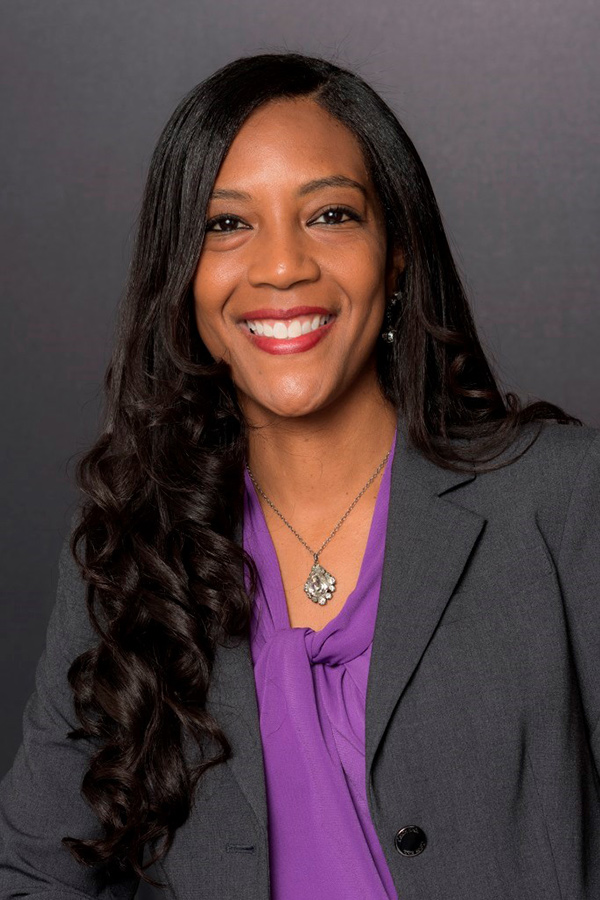
Q&A with Qiana Spain,
Executive Vice President and Chief Human Resources Officer
I envision that whatever we do, it will be sustainable—beyond any individual or leader. Our primary goal is that Diversity, Inclusion & Belonging (DI&B) will become part of Amtrak’s DNA, which means it must continuously evolve. I want us all to strive to be bigger than where we are at any given moment. The way we do that is by being honest about who we are, where we are, and how we treat each other.
We initiated the first annual DI&B report which demonstrates we are diverse in certain populations, but also clearly indicated gaps in other populations such as management and senior leadership positions. To become a better company, we need more diverse representation where important decisions are made. These decision makers should reflect our consumers and have varying perspectives to drive stronger connections to our passengers and our communities, including on the topic of sustainability.
We will publish this report annually and make it available on Amtrak.com. Within the report are metrics related to gender, age, and ethnicity. As we launch training, new hiring guidelines, and career advancement targets, we will monitor change within these metrics.
Our customers will benefit from a stronger DI&B culture because they will receive more innovative ideas and offerings. Our riders primarily interface with our frontline employees, and it takes the greater work of all Amtrak employees to create a stronger DI&B culture and enhance connectivity to our customers. If our employees at all levels in the organization reflect the 500 communities we serve, we will be more connected to their values and needs. This should result in increased ridership, higher customer satisfaction, and increased investment from our key stakeholders.
We must listen to our frontline employees because they are in the stations, on the trains, in the yards, and know firsthand what our customers are asking for and experiencing. Our back-office employees have a deep knowledge of our financial systems, IT systems, HR processes, and can provide input on how to enhance these areas so we can better service our customers.
We are having important conversations by engaging employees whose experiences have historically been ignored or undervalued and asking them to provide input on what will make Amtrak more inclusive. This is an important step to building a culture where employees feel a strong sense of belonging. We will continue these conversations and take it further with accountability, transparency, and with the full support of the Executive Leadership Team and the Board of Directors. We know we have work to do across all departments to be better.
In my opinion there are two primary external influences that could help Amtrak achieve our goals more wholly and quickly. The first is how we respond to the impact of COVID-19 on our business. Every organization is in the process of figuring out how to survive the pandemic. We are identifying processes and policies to help manage the impacts to our workforce, many of whom are challenged with unexpected caregiving responsibilities, illness, quarantine, or even death. Like other companies, it’s been critical to value the external public health and social stressors our colleagues and communities faced and the effect this had on and off the clock. People will remember how we treated them during this time. Did we communicate, were we transparent in our decisions, did we show empathy towards each other?
In addition to a global pandemic, we were faced with tremendous social turmoil in our country. This social unrest starkly highlighted gender and racial inequalities. The Executive Leadership Team chose to proactively address how these events impacted our communities and our company. We looked in our own house and questioned Amtrak’s outdated hiring practices, policies, and unbalanced demographics. We are proactively addressing these disparities as our core work and journey continues.
As one of our first steps, we’re re-establishing partnerships with outside organizations for support, inspiration, and a pipeline of diverse perspectives. Organizations like WTS and the National Society of Black Engineers can be a bridge for us to bring in talent and they help us achieve our commitment to change. New talent with varying perspectives enriches our workplace and breaks down silos.
We must truly embrace our Values: Do the Right Thing, Put Customers First, and Excel Together. I know that sounds basic, but it really is that simple. To achieve the vision I shared earlier, people must become comfortable having uncomfortable conversations. We need to stand up for others, even when those issues do not impact us directly. Our leaders must be accountable for their behavior because change starts at the top. When ideas aren’t being heard or valued, they must be the ones to speak up. By doing this, they will set the expectation of appropriate behavior.
Although change starts at the top, change sustains when it is embraced throughout the organization. We need to address our unconscious bias and build self-awareness. To support this work, we’re developing training on allyship, unconscious bias, and best hiring practices. These levers move a company from awareness to culture change.
Surviving 2020 brought Amtrak together. We recognized our flaws, but we also bridged existing divides - proving we can propel the company through something this difficult with shared values and goals. We move forward more effectively when we leverage these behaviors we’ve shown during these crisis’ and implement them in action in our daily activities.
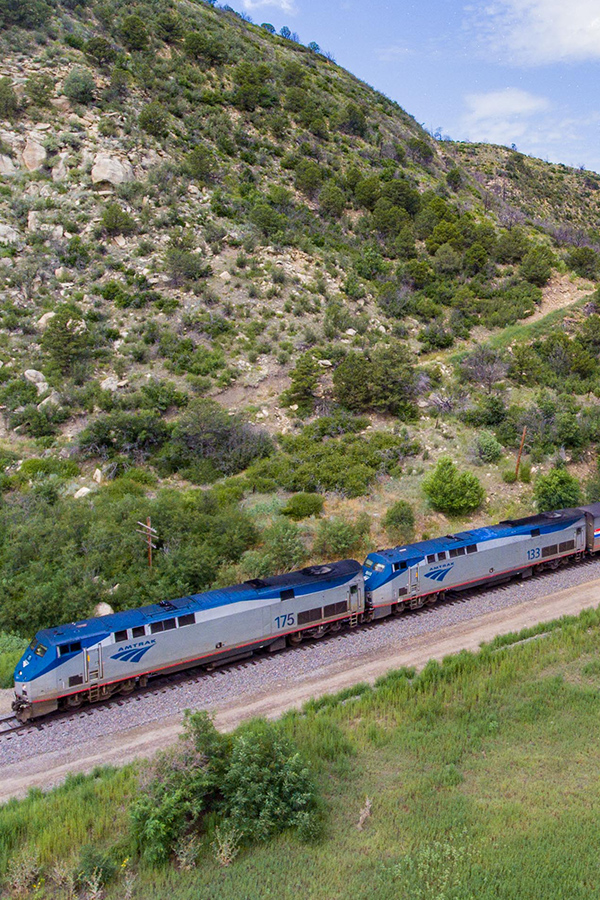
At the National Railroad Passenger Corporation (Amtrak), we work with our partners to help move people, the economy and the nation forward. Our mission, as defined by the U.S. Congress through the Passenger Rail Investment and Improvement Act of 2008, is to “provide efficient and effective intercity passenger rail mobility consisting of high-quality service that is trip-time competitive with other intercity travel options.” Amtrak operates a network of intercity passenger rail services spanning 46 states, the District of Columbia and three Canadian provinces.
Amtrak is a federally chartered corporation, operating as a for-profit company, with the federal government as majority stockholder. Members of the Amtrak Board of Directors are appointed by the President of the United States and confirmed by the U.S. Senate. The company was created by an act of Congress in 1970 to take control of the majority of the nation’s intercity passenger rail services. We’ve been helping people go places since daily operations began in May 1971. Taking into account Amtrak’s Northeast Corridor, State Supported and Long Distance service lines, shared intermodal stations, and infrastructure access and services provided to 13 state and regional authorities for commuter services from coast to coast, our services are used by more than 348 million travelers a year (pre-COVID-19).
Visit our Media Center to learn more about Amtrak and download our latest fact sheets.
Highlight Stories
Long Distance
State Supported
Northeast Corridor
Suspended Service
Our COVID-19 Response
The safety of our customers and employees is not just a priority at Amtrak — it’s a necessity. When the COVID-19 pandemic reached the United States, we were unsure of the future, but we knew public safety was our number one focus.
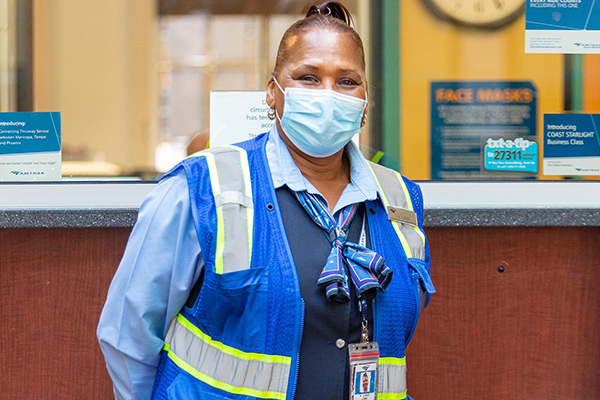
We knew that we could not continue to operate safely without the dedication of our frontline employees who are essential to our train service. We are humbled and grateful to the thousands of men and women who keep our trains running smoothly during this difficult time, showing that we are all, indeed, in this together.
From the beginning, Amtrak relied upon the Centers for Disease Control (CDC) to ascertain public health protocols best suited to protecting our workforce and customers. We instituted contactless boarding, mask mandates, enhanced cleaning practices, and cashless travel. We implemented social distancing measures, and we limited bookings on reserved trains to allow for physical distancing. These standards continue in the face of the ongoing pandemic, with support from the federal government, which now mandates masks on all forms of transportation. A year later, the technological innovations we implemented in response to public and employee health and safety concerns are allowing us to remain one of the safest, cleanest inter-city transportation options.
As many employees work remotely, we’ve worked hard to bring camaraderie and teamwork into the safety of our homes through regular town hall events led by our leadership team and maintaining consistent communications across varying internal channels. Clear and accurate information is critical to decision-making — we’ve shared over 250 COVID-19 related emails, newsletters, and posts regarding safety measures, work from home guidance, mental wellness tips, and important information to keep our employees knowledgeable and up to date.
Our dedication to the safety of our employees and customers has enabled us to continuously provide intercity rail transportation across America. For the latest safety measures at Amtrak, visit Amtrak.com/coronavirus.
Amtrak Celebrates a Half-Century of Service
In 1971, when the first passenger train operated by the new National Railroad Passenger Corporation (Amtrak) left the station, no one could imagine what lay ahead. Amtrak faced a formidable set of challenges: equipment was aging and in the face of competition from highways and air travel, ridership had declined.
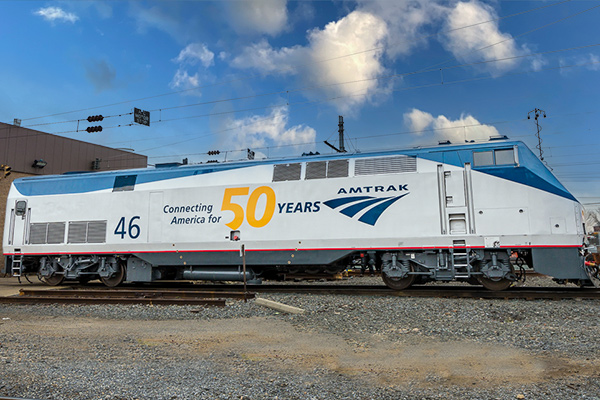
Knitting together one integrated, national rail system from 20 disparate railroads wasn’t easy, but the people of Amtrak got to work creating an organizational framework, hiring and training employees, upgrading its fleet, improving stations and maintenance facilities acquired from predecessor railroads, creating a national reservations system, enhancing customer service and introducing new amenities to attract customers onboard its trains.
Today, Amtrak operates a national system connecting more than 500 destinations in 46 states, the District of Columbia and three Canadian provinces, on more than 21,400 network route miles. As the nation’s only high-speed intercity passenger rail provider, Amtrak has partnered with 17 states through 20 agencies to provide train service across America.
Amtrak’s bold vision for the next 50 years includes investing in innovative equipment and new technologies, protecting vital rail infrastructure from climate change, reducing greenhouse gas emissions, and expanding access to new communities. As Amtrak puts this vision into action, social equity, sustainability, and climate resilience are shaping the future of Amtrak’s business. At the heart of Amtrak, there have always been great people, people who believe in the power of staying connected to faraway places, to our history, to what’s next and to each other.
That’s why the future rides with us.
Moynihan Station, New York City
On January 1, 2021, the doors of Daniel Patrick Moynihan Train Hall officially opened to the public after nearly three decades of planning and collaboration among Amtrak, the state of New York, private developers, and public partners. Located in the heart of Manhattan, adjacent to New York Penn Station, this $1.6B transit hub exemplifies a vision of the future of rail transportation and adaptive reuse.
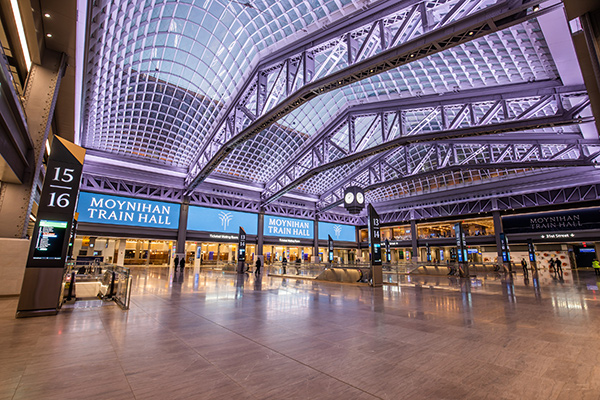
Sustainability was a focal point of the project and the design team is currently pursuing the Leadership in Energy and Environmental Design (LEED) Transit certification for its sustainable design and construction. When customers come up to the main concourse, they’re welcomed by natural light and spacious rooms with 92-foot ceilings and overhead parabolic skylights, created by reusing the building’s steel trusses. LED lights are used on the train information displays lining the wall and the escalators are equipped with smart features, including heaters to ensure reliability during cold weather and a “sleep mode” that will save energy and increase durability. The entire project was based on restoring and upgrading an historic building to be reused as a durable, modernized transit center which will serve our customers proudly.
Contributing to the welcoming atmosphere is beautiful artwork curated by local New York artists that line the walls and ceilings of the station. Magnificent pieces liven up the modern space, enhancing the experience for travelers and encouraging appreciation for various forms of expression. The ceiling at West 33rd Street depicts young Black New Yorkers breakdancing while 30,000 pounds of futuristic skyscrapers hang upside down from the West 31st Street entrance. The station serves both Amtrak and Long Island Rail Road passengers, who can enjoy the open space, natural light, and general grandeur as part of their travel experience.
“The opening of the Moynihan Train Hall on January 1, 2021 was the result of incredible perseverance by the team in the face of a global pandemic. What an honor to present this beautifully repurposed space, including all its natural light, to our customers and the City of New York.” Celia Pfleckl, Senior Director of Program Management, Amtrak
The future of rail is now. It’s collaborating with various partners, reusing and optimizing existing infrastructure, and preparing our urban centers for the modal shift away from planes and cars to trains.
Diversity, Inclusion and Belonging
Since the pandemic, we’ve seen the Asian American community endure an epidemic of hate as incidents have intensified resulting from rhetoric and bias. As we continue to Stop Asian Hate, we must also commit ourselves to stand with our Asian American colleagues and friends. Simultaneously, protesting the treatment of people of color and calling out systemic racism and police brutality, the Black Lives Matter movement sent waves across the nation last year. We must act as allies and amplify their stories and struggles. There is no room for hate or prejudice in our society, our communities or at Amtrak.
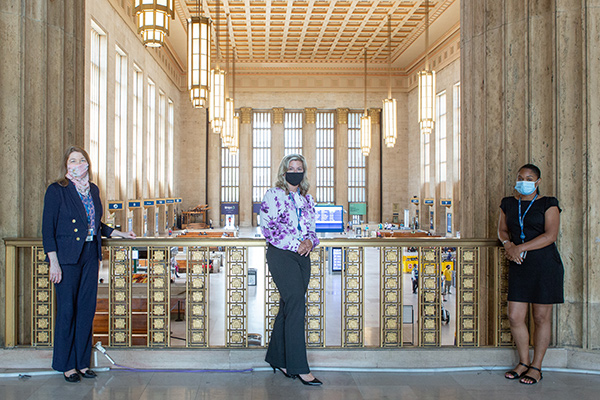
The civil rights movement has brought about critical conversations about the disparities in treatment and equal representation. All of us have been called upon to self-examine, take accountability and practice allyship to create an environment of diversity, inclusion, and belonging. Making progress requires all of us to promote actions that are unbiased and just. Here at Amtrak, we want to do what we can to create change, not just for the communities we serve, but for our employees and workplace culture. In this time of reckoning, Amtrak chose to reflect on its own policies and practices, adapting and learning from employees and customers how to best create an open environment for all individuals.
In 2020, we released our first Diversity Report, which provides transparency into the workplace demographics at Amtrak, and took responsibility to ensure a diversified, resolute workforce. To create pathways of belonging, deliberate actions must be taken to ensure change is brought about in a sustainable manner. We don’t have all the answers, but we do know we will get through this, together. Our DI&B mission statement, as stated in the Report, is “to become the preferred, safest provider of intercity passenger transportation in the country by building upon and leveraging our diversity, fostering inclusion and creating a workplace that produces ‘a sense of community’ for all employees.” We intend to keep learning and bettering ourselves, until we accomplish just that.
“We are cultivating a culture of inclusion that will ultimately foster a sense of belonging. We have made tremendous progress and established a strong foundation for the future.” Benjamin Sims, VP of Diversity, Inclusion and Belonging
To meet our GOALS, we define
- Diversity as how we look and thinkcollectively.
- Inclusion as the deliberate act of making sure people with different experiences and backgrounds are included in groups, structures, teams and activities.
- Belonging as the ultimate outcome of diversity and inclusion. A sense of belonging is what we want our people to feel when they work at Amtrak. It is the sense that employees are valued and that they contribute and make a difference.
To PROGRESS on this path, we
- Held 20+ group conversations with employees focused on race and the workplace.
- Assigned “Introduction to Bias” and “Introduction to Diversity Awareness” courses to all Amtrak agreement and nonagreement employees.
- Implemented Recruiting Guidelines to ensure our recruitment strategy supports a diversified workforce.
- Further incorporated Diversity, Inclusion and Belonging into our policies and practices.
Food Finders
In 2019, 10% of Americans faced some level of food insecurity, not knowing where or when they would have their next meal and more than 35 million Americans struggled with hunger. In a study by the Los Angeles Food Policy Council, 30% of Los Angelenos struggled for consistent access to food. To address this chronic problem, work is underway to rescue surplus food from waste to get it into the hands of those who need it to stave off hunger.
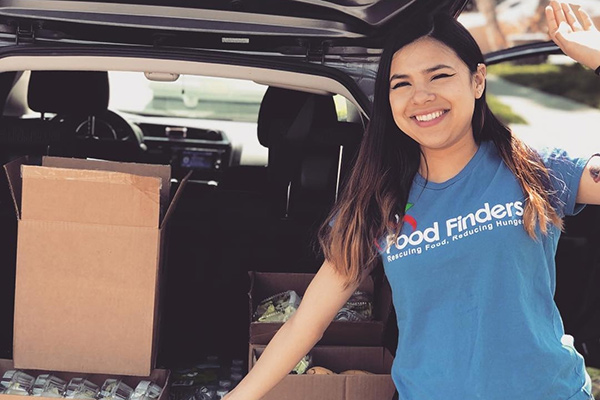
Amtrak’s largest West Coast train yard is in the heart of downtown Los Angeles. Operations at this facility include food storage and preparation for our long-distance trains. For years, the Los Angeles Amtrak environmental and food service teams have maintained strong partnerships with local food banks and shelters to donate surplus food to those facing food insecurity and hunger while preventing food from going to landfills. In early 2020, Amtrak prepared for the uptick in spring break travelers by stocking packaged goods and perishable items. Once impacts from COVID-19 directly affected Amtrak operations and reduced train schedules, the perishable food in our facilities was at risk of becoming waste. Our Los Angeles teams immediately called their local food rescue partner, Food Finders, to collect perishable items, linens, and towels.
“Our participants are thrilled when we have the sandwiches, the salads, the fruit, and the snack packs from Amtrak. We have had several events and were able to utilize the paper goods as well, which saved us financially not having to purchase paper goods.” Gwynn Browne, Food Finders
Food Finders is a 501c3 non-profit organization started in 1989 that serves Southern California, including L.A. County, and acts a resource for businesses like grocery stores, farms, and corporate kitchens, including Amtrak, that donate surplus meat, dairy, produce, and packaged goods. The food is then distributed free-of-charge to its network of 400 nonprofit partners, which includes food pantries, shelters, community centers and more. Connecting donations to the community closest to the product gets the food to those who need it faster and reduces Food Finders’ operational emissions in a region known for traffic. In their 31 years of community service, Food Finders has rescued 178,000,000 pounds of food. In 2020, Amtrak contributed 85,000 pounds to the local Los Angeles community through this valuable network of “angels”. This is one of nine food donation programs Amtrak supports in several major metropolitan areas.
Climate Resilience Planning
According to the National Oceanic and Atmospheric Administration (NOAA), 2020 was the sixth year in a row that saw more than ten $1 billion storms in the U.S. NASA also reported the last decade (2010-2019) was the hottest in recorded history. In fact, July 2020 was the hottest month on record in the Northern hemisphere and the second hottest month on record for the planet. A changing climate is resulting in more frequent, damaging, and severe weather events like wildfires, hurricanes, and heat waves — putting our communities, economies, and ecosystems under stress.
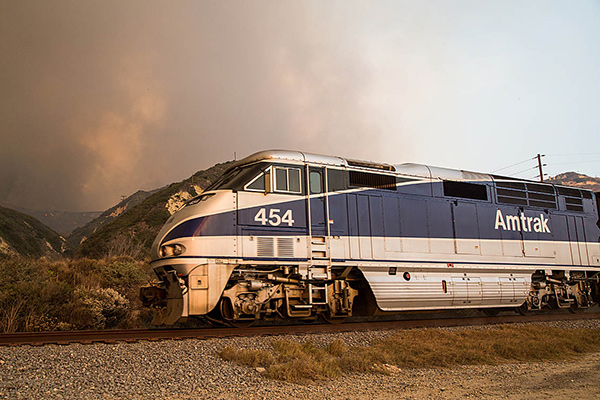
As an essential service, Amtrak must operate safely in various conditions like snow, heavy rain, and extreme heat and cold. During and after heavy precipitation events, we’re seeing overwhelmed culverts, inundated sections of track and electric substations, erosion, and mud slides. Conditions are further exacerbated by upstream development and swollen streams and tributaries adjacent to Amtrak’s rail. Based on a recent weather data and revenue analysis, since 2006, Amtrak lost over $127M in revenue due to named storms and severe weather disruptions, with a projected loss (based on historic costs) of an additional $220M by 2030. Based on predicted storm surge and flood maps, if we continue business as usual, we are exposed to increasing operational, financial, and reputational risks.
Recognizing that our changing climate is adversely affecting our operations now and will continue to do so at an increasing rate, Amtrak began investigating our climate-related risks. Over the last five years, we made substantial progress in greenhouse gas emission reductions, updated engineering design standards, began work on a Climate Resilience Strategic Plan, and expanded the involvement of multiple departments in this work. Starting in FY20, we outlined the vision for a comprehensive strategic plan to pull together resiliency work already underway and set goals for the future. The main objectives of the Climate Resilience Strategic Plan are to better understand our current business practices, available data, vulnerabilities, and climate risks. As we identify goals and objectives for ensuring resiliency in our in our supply chain, operations and infrastructure, we will establish priorities and metrics to track progress.
The strategic plan will outline where and how we can best absorb external disturbances, maintain the core mission and functions of Amtrak, and safely recover to previous or improved conditions. What we are undertaking requires involvement across all departments and collaboration with state and federal partners, host railroads, climate experts, scientists, transit agencies, and other stakeholders.
Instead of creating a standalone climate program, we’re working to integrate assessments, actions, policies, and amended business practices across departments. The first phase of the strategic plan focuses on the Northeast Corridor with future phases dedicated to the National Network. Look for updates as we set forth our action-oriented plan on Amtrak.com/Sustainability.
Washington Union Station Outreach Services
With an annual ridership of just under 5 million, with approximately 85-90 trains departing the station daily, Amtrak’s second-busiest station, Washington Union Station, is a major transportation hub and leisure destination located in Washington, DC.
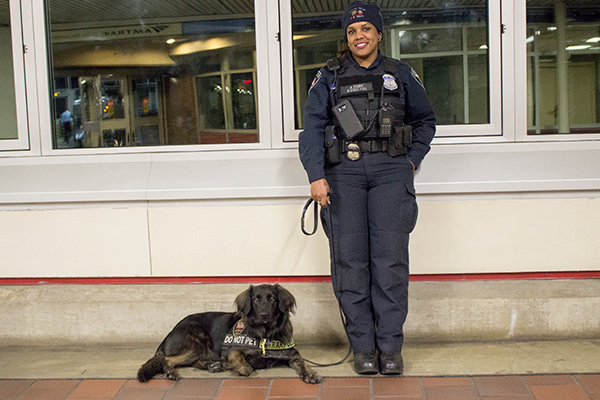
The station hosts 3 levels of shopping and dining and a 4-level parking garage, and is visited by over 40 million people each year. In addition to Amtrak, the terminal is served by METRO, and the MARC and VRE. It is the main bus terminal of Washington, DC as well as a drop off and pick up center for many DC tour bus operators.
Like most major transportation facilities that are open to the public, Washington Union Station sees individuals experiencing a range of social and economic vulnerabilities.
In FY20, Amtrak’s Police Department and the Washington Union Station property owner developed a program to provide targeted outreach and services by engaging a social services specialist to help with:
- accessing community resources, such as transitional and rapid re-housing,
- encouraging movement into permanent supportive housing;
- accessing reunification, employment and other community resources;
- identifying and communicating healthcare opportunities and providing referral and transportation as needed; and
- escorting participants to appointments and services.
This pilot program was so successful in its first year that Amtrak is expanding the Outreach Services model to other major stations, including New York Penn Station.
Composite Ties
Crossties are a critical material for every railroad. They are an integral piece of track construction as they hold the rails together and provide a stable foundation for train operations and smooth rides for our customers. Like all railroads, Amtrak has a crosstie maintenance program and we’ve begun replacing creosote-treated wood ties with composite ties in New Orleans, LA and Sanford, FL, and expanding to Hialeah, FL and Philadelphia, PA later this year.
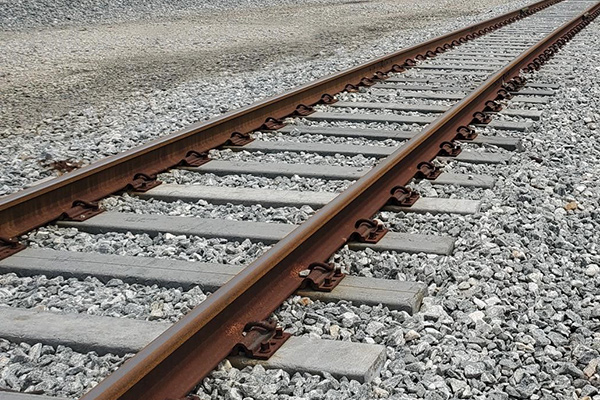
Crossties—manufactured from creosote-treated wood, concrete or composite materials—are subject to rigorous testing and manufacturing requirements to perform under high and low speeds, varying humidity levels, extreme temperatures, and daily exposure to ultraviolet light. Some composite ties are manufactured from 200 lbs. of 100% post-industrial and post-consumer plastic, reinforced with glass fiber. The plastics are supplied through municipal and city recycling programs, which support domestic jobs and the recycling economy. They are absent of harmful chemicals. They resist rot, water, and pests; and after 50+ years of use, these composite ties can be recycled again and again. This kind of material innovation is part of Amtrak’s work to protect our shared natural resources and ecosystems using new materials and responsible design.
Historically, creosote-treated wood ties were commonly used, especially when timber from trees that grew up over hundreds of years, known as old growth hardwood, were widely available. Currently however, the supply chain for hardwoods has changed, as timber from trees that have grown rapidly become readily available. The change from old growth hardwood to new growth hardwood resulted in softer, less dense ties from fast-growing timber harvested in the southern United States. The lifespan of less dense creosote-treated ties is shorter and requires replacement sooner, thus adding more cost to material, labor, and disposal.
In addition to wood tie quality issues, their end of life disposal has become more challenging. Once the wood crossties are removed, they must be managed responsibly through recycling, incineration, or landfill disposal. Fewer facilities accept creosote-treated ties, making all disposal options more difficult. Recently, state regulations have begun limiting the presence of creosote-treated materials near marine life to protect water quality and marine ecosystems. As hardwood quality declines, costs increase, and regulations change—innovation has emerged as a viable solution. Amtrak is proud to integrate innovation into our supply chain and rail tie maintenance program by expanding a pilot composit tie program across a greater range of our network operations.
Want to learn more? Visit Amtrak Sustainability.

Railroad Safety
Customer Injury Rate
Over the past three years, data trends indicated a disproportionate number of customer injuries associated with escalators. To reduce customer injuries Amtrak implemented a variety of mitigations to enhance escalator safety.
FY19
16.74 incidents
FY20
15.62 incidents per 100 million train miles
(-6.7% YOY)
Railroad Safety
Employee Injury Rate
The newly launched Safety Starts With Me training program educates employees on how to proactively identify and mitigate risks in the work environment. Also in FY20, Amtrak deployed the Aware application on non-PTC routes, providing conductors with an enhanced situational awareness tool on electronic mobile devices.
FY19
3.41 incidents
FY20
2.78 incidents per 200,000 working hours
(-18% YOY)
Railroad Safety
National Transportation Safety Board Accidents
In the last year, Amtrak increased field observations, planned audits and launched the “We’re All-Ears” campaign to promote voluntary safety reporting across all Operations departments.
FY19
0 incidents
FY20
0 incidents
(0% YOY)
Railroad Safety
Trespasser and Grade Crossings Incidents
To reduce grade crossing incidents, Amtrak partnered with Waze to add a proactive feature within the navigation app which alerts drivers in advance of grade crossings.
FY19
9.68 incidents
FY20
11.02 incidents per 100 million train miles
(14% YOY)
Railroad Safety
Positive Train Control (PTC)
As of December 31, 2020, 100% of Amtrak route miles with PTC are now operational and 100% of Amtrak trains are operating with PTC. In addition, Amtrak is now interoperable with all of its tenant and host railroads. Get more info on PTC.
FY19
All Amtrak-owned or controlled track had PTC in operation, except roughly 0.9 miles which are expected to be completed by June 2020.
FY20
Amtrak completed all PTC implementation required for compliance by the Federal Railroad Administration’s regulatory PTC deadline.
Supplier Diversity
Suppliers
Amtrak has a corporate goal of making 10% of total enterprise expenditures with woman-, minority-, veteran-, disabled-, or Native-American-owned suppliers, and the company exceeded that goal in FY20.
FY19
14%
FY20
12.5%
Service to Communities
New or Relocated Stations for Existing Intercity Rail Service
The new Buffalo Exchange station was designed and constructed by NYSDOT in partnership with Amtrak. The new station includes a larger, “more comfortable” fully ADA compliant station with restrooms and a Passenger Information Display System. The station also includes a high-level platform for “level boarding” of the train, removing the need for steps to get on or off.
FY19
7 stations
FY20
1 station
Service to Communities
Accessibility Projects
Together, Amtrak, the Ashland, Virginia Historic District, and the Secretary of the Interior designed solutions to maintain the fabric of the of the Ashland, VA station’s historic details — such as brickwork, railings, and the glass canopy — while making necessary improvements to meet ADA standards.
FY19
33 completed projects
$78M
FY20
41 completed projects
$103.4M